Blackhawk War of 1832
Chief Black Hawk
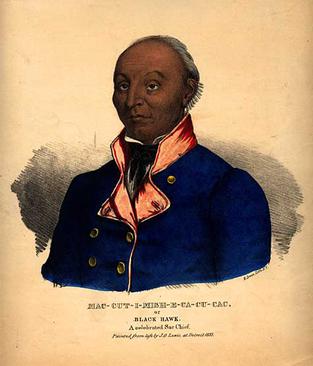
Black Hawk, whose full name was Black Sparrow Hawk, was born in 1767, at Saukenauk an area three to five miles north of where the Rock River in Illinois meets the Mississippi River located near present day Rock Island, Illinois. . This location is near present-day Rock Island, Illinois. In his native tongue, his name was Ma-ka-tai-me-she-kia-kiak. Contrary to popular belief, Black Hawk was never a chief. He was a warrior and a recognized leader among the Sauk and Mesquakie (Fox) nations, but he never achieved the rank of chief. Black Hawk was married to a woman named Singing Bird. Together they had two daughters and three sons. Among Black Hawk's descendants was legendary athlete Jim Thorpe. Thorpe was Black Hawk's great-grandson.
In the early 1800s the Sauk and Fox Indians lived along the Mississippi River from northwestern Illinois to southwestern Wisconsin. Black Hawk fought on the side of the British in the War of 1812. He and his followers, known as the British Band, were responsible for the victories at Campbell's Island and Credit Island. Black Hawk had done his best to force American settlers off the western frontier.
In 1830, seeking to make way for settlers moving into Illinois, the United States required the Sauk to move and accept new lands in present-day Iowa. There they struggled to prepare enough acreage for their crops. The winter of 1831-1832 was extremely difficult. In April 1832, Black Hawk led about one thousand Sauk and Fox people back to northern Illinois. Black Hawk hoped to forge a military alliance with the Winnebago and other tribes. They intended to plant corn on their ancestral farmland were they had been forcibly removed to the year before. Fearing the Sauk, Illinois settlers promptly organized a militia.
Observing the military forces organizing against him, Black Hawk reconsidered his actions and decided to surrender. Yet an undisciplined militia ignored a peace flag and attacked the Sauk. The Indian warriors promptly returned fire. The militia retreated in a panic, many forgetting their firearms. The Sauk collected the weapons and retreated northward along the Rock River into Wisconsin. The Black Hawk War had just begun. General Henry Atkinson was in charge of U.S. Army forces, assisted by four thousand militiamen led by Henry Dodge and James Henry. Abraham Lincoln, Jefferson Davis and Zachary Taylor all served in the war as young army officers.
Traveling with small children and elderly members of the tribe, the Sauk and Fox were unable to move as rapidly as the soldiers. In an effort to distract the Americans, Sauk warriors raided frontier farms and villages. On July 21, 1832, soldiers led by Henry Dodge caught up with Black Hawk's band near the Wisconsin River, outside of present-day Sauk City. Although greatly outnumbered, Sauk warriors turned the attack on American troops, allowing the Indian women and children to flee across the Wisconsin River. The next morning, the American troops discovered that the Sauk warriors had vanished, having quietly forded the river in darkness. Dodge subsequently fell back, journeying north to Fort Winnebago (near present-day Portage) to obtain supplies. At Fort Winnebago, Dodge joined forces with Atkinson and set out in pursuit of the Sauk and Fox. Most members of the starving band had fled west, hoping to find sanctuary among tribes beyond the Mississippi River.
On August 2, U.S. soldiers attacked the Sauk and Fox as they attempted to ford the Mississippi River, near what is now Victory in Vernon County. Ignoring a truce flag, the troops aboard a river steamboat fired cannons and rifles, killing hundreds, including many children. For the next eight hours the volunteer militias used axes, guns, cannon, and clubs to cut down the Indian warriors while women and children who succeeded in swimming the river were slaughtered on the other side. Around 90% of Black Hawk's people were slaughtered and the Mississippi ran red with their blood. Many of those who made it across the river were slain by the Eastern Sioux, allies of the Americans in 1832. Only 150 of the one thousand members of Black Hawk's band survived the events of the summer of 1832. Survivors rejoined the Sauk and Fox who had remained in Iowa.
The war lasted just 15 weeks, ending on August 1, 1832, at the Battle of Bad Axe, Wisconsin. Black Hawk surrendered to officials at Fort Crawford, Prairie du Chien. The defeated warrior was imprisoned and sent east to meet with President Andrew Jackson and other government officials. Eventually the U. S. government sent him to live with surviving members of the Sauk and Fox nation.
Black Hawk himself, captured and imprisoned, was paraded around the U.S. in chains; after he died his skeleton was displayed in the governor's mansion in Iowa, like a trophy. Black Hawk died on October 3, 1838, of a respiratory illness. He was buried sitting up inside a small mausoleum of logs but his grave was robbed soon afterward. His remains were later deposited in a museum in Burlington, Iowa. The museum and its contents were destroyed by fire in 1855.
Background Information
The Battle of Bad Axe was the last Indian-American battle fought east of the Mississippi River. After realizing the futility of fighting the U.S. troops, Black Hawk's British Band of Sauk attempted to escape across the Mississippi River. At this point the last battle began, resulting in the deaths of nearly 150 of Black Hawk's followers. This two-day long battle took place in what is now the Black Hawk Recreation Park and the surrounding floodplain and uplands.
Tensions Begin to Surface
Saukenuk, at Rock Island Illinois, had been the principle Sauk village for nearly a century before the U.S. made the Louisiana Purchase in 1803. Here, they farmed in the summer and went on annual winter buffalo hunts in Iowa. Following the Louisiana Purchase, tensions rose between the Sauk and American settlers, who began moving into the area. Soon thereafter, a party of Sauk killed several settlers, causing the government to demand that the murderers be turned in. In Sauk custom, retribution was offered. The government refused and demanded a treaty, which contained a provision allowing the Sauk to remain on the land until it was sold to private parties. This provision was not understood by the unauthorized Sauk delegation which signed the document.
The continuing tension between the Sauk and the Americans led to division within the Sauk tribe. Black Hawk and his followers chose to stay at Saukenuk, while others followed the war chief Keokuk, who sought to lessen the impact of American settlers on their lives by leaving for Iowa to the west.
During the lead boom of the 1820's, some of the Sauk left for Iowa, but Black Hawk's British Band returned to Saukenuk until 1830-31. White settlers began moving into the area when land sales began around 1829. After a near attack by militia troops in 1831, Black Hawk signed a treaty agreeing to American terms. However, Black Hawk and his followers soon returned to the Rock River after believing stories of support from the Winnebago, Potawatomi, and the British in Canada.
Start of the War - April 1832
At this time, Black Hawk's "British Band" consisted of some 2000 men, women and children. At the age of 65, Black Hawk returned with his band to White Cloud's Winnebago village. The arrival of U.S. troops under the charge of General Henry Atkinson caused the band to move further up the Rock River. Here Black Hawk learned that the other tribes and the British Army would not support the British Band.
The mounted militia, in advance of U.S. troops, burned White Cloud's village and continued to pursue the band. A delegation of the band was sent to surrender to 200 militia members under Isaiah Stillman. The militia distrusted the band's white flag, and killed one of the scouts. Black Hawk responded by setting up a small defensive ambush in which several of the militia were killed.
The British Band fled north to the swamps of southeast Wisconsin for several weeks. Finally, facing starvation, the band headed north and west through the Madison Lakes around the lead district towards the Wisconsin River. Meanwhile, two militia patrols under Henry Dodge and Alexander Henry found the trail and set off in pursuit.
Battle at Wisconsin Heights - July 21, 1832
Dodge and Henry's militia caught up with the band as they prepared to cross the Wisconsin River. A rear guard tried to divert the militia away from the main body of women and children, and suffered heavy casualties. When the shooting stopped, the remainder of the band crossed the river. Some opted to float down the Wisconsin towards Iowa while 500 followed Black Hawk northwest towards the Mississippi River.
Dodge and Henry's militia caught up with the band as they prepared to cross the Wisconsin River. A rear guard tried to divert the militia away from the main body of women and children, and suffered heavy casualties. When the shooting stopped, the remainder of the band crossed the river. Some opted to float down the Wisconsin towards Iowa while 500 followed Black Hawk northwest towards the Mississippi River.
Battle at Bad Axe - August 1, 1832
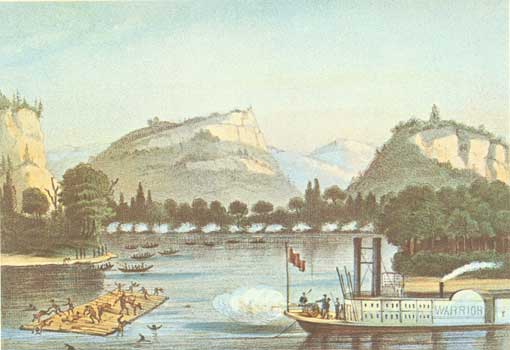
The remnant British Band crossed the Kickapoo River and followed the ridgetop to the present day village of Red Mound. At this point, the band began working its way down Battle Hollow to the floodplain bench at its mouth. Once the floodplain was reached, the band prepared to cross the Mississippi River by stripping elm trees for bark canoes and cutting timber for rafts.
The pursuing army was only 10 miles behind, having crossed the Kickapoo at Soldiers Grove, and headed for the ridgetop. There they passed the bands previous night's camp near present day Retreat.
Shortly after the British Band reached the banks of the Mississippi River, the steamboat WARRIOR approached from upstream and the troops on board observed their presence. The Sauk stood unarmed along the shore and offered a white flag.
"Lieutenant Kingsbury, who commanded, stated that they hoisted a white flag but would not send [a representative] aboard the steam boat...so accordingly he fired his six pounder, and likewise opened a fire of musketry upon them when they commenced a heavy fire upon the boat" -John Wakefield, Surgeon's Mate
For the next hour or so, the Indians skirmished with the WARRIOR, their musketry having little effect, while the cannon and musketry from the boat took greater toll. As the boat ran low on fuel it quit the fight returning to Prairie du Chien to refuel and rearm.
The first day of the Battle at Bad Axe resulted in the deaths of 23 Sauk, who where apparently buried that evening. That night, Black Hawk and three lodges left the main body with the intent of joining the Chippewa to the north of the LaCrosse Winnebago. This group backtracked eastward up the bluffs, where they became aware of the Army's proximity. They then established a rear guard between the Army and the main Sauk band on the floodplain below
"I now began to fear that the whites would come up with my people and kill them before they could get across. I had determined to go and join the Chippewas; but reflecting that by this I could only save myself, I concluded to return and die with my people..." -Black Hawk
The Battle Continues - August 2, 1832
Atkinson awoke his troops at 2:00 a.m. to continue their march. The army broke camp while Alexander and Henry's militia brigades were delayed in trying to gather their horses. An advance moved westward over the ridgetop with Brigadier General Alexander Posey's Brigade in the rear.
As the sun rose, the troops witnessed the fog filled Mississippi Valley looking down on Battle Hollow. About 6:00 a.m., Dickson's spies encountered the rear guard of Indians and shooting began.
"During the battle that ensued, my command killed fourteen Indians. After a short time, say an hour's engagement, General Dodge with his force and General Atkinson with this regular army, arrived at that place where I had engaged this party consisting of about forty Indians; and at about the time of their arrival, we had killed and dispersed the whole party." -Captain Joseph H. Dickson, Michigan Territory Militia
During the skirmish the Indians lost about 14 while the spies suffered one critically wounded. The remaining rear guard attempted a diversion by withdrawing northward into the wooded ravines leading towards the Bad Axe River and away from the main band on the Mississippi. Atkinson arranged his forces into five parallel lines. The northern three of which followed the diversion towards the Bad Axe River.
Bringing up the south position was Henry's militia which found the Sauk trail leading down Battle Hollow. He and Dickson's spies followed this to the floodplain finding the main camp at what is now the Black Hawk Recreation Area.
At about 9:00 a.m., Dodge's militia and some Infantry troops descended Battle Bluff to the floodplain and joined the fighting.
The Indians fought back with desperation, but little effect. The dense forest and underbrush, fallen logs, backwater sloughs and thick marsh grass offered numerous hiding places and slowed the attacking forces, but also caused confusion in which the army killed untold numbers of women and children. The soldiers' advances forced some Indians into the river, while others continued to resist fleeing down the floodplain onto a series of willow bars. Here more Indians were killed while others jumped into the river. "...many of them men, women and children fled to the river and endeavored to escape by swimming in this situation. Our troops arrived on the bank and threw in a heavy fire which killed great numbers, unfortunately some women and children which was much deplored by the soldiers..." -Lieutenant Albert Sidney Johnson, Atkinson's Aide de Camp
Then the steamboat WARRIOR returned from Fort Crawford at Prairie du Chien and immediately began raking a series of islands with the cannon. This drove some Indians who had made it across the channel into trees while sharpshooters on the boat picked off others seeking protection along the bank or swimming in the river. Later, the WARRIOR transported Zachary Taylor's Infantry and some militia over to the islands, which were swept in extended fashion, resulting in the killing of several Indians while a number of women and children were taken prisoner.
Aftermath of the Battle
"They were now completely overthrown and beaten with the loss of 150 killed, 40 women and children taken prisoners and their baggage and about 100 horses killed and captured with a loss on our part of five regular killed and four wounded, six of Dodges battalion wounded, six of Henry's wounded; one mortally and one of Posey's brigade, this action was decisive, the remnant of the band fled to the west of the Mississippi..." -Lieutenant Albert Sidney Johnson, Atkinson's Aide de Camp
By early afternoon, the battle diminished and the Army established a headquarters and surgery on the east bank of the river. Later the prisoners and wounded were transported to Fort Crawford on board the WARRIOR. Along the way, the passengers observed bodies floating down river and noted that the river was tinged red from the blood.
For the rest of the day and next, troops and militia busied themselves with gathering their horses from the bluff, collecting valuables and capturing Indian horses. It also appears that five whites and a Menominee ally killed during the battle were buried at the battle site. On August 4, Atkinson ordered his entire force back to Prairie du Chien; the infantry aboard the steamboat WARRIOR and the mounted militia via the east shore of the river.
Most estimates of the number of Indians killed at the Battle of Bad Axe refer to upwards of 150. The full figure will never be known due to those shot or drowned in the river. Other than the 23 persons allegedly buried on the night of August 1, it is probable that the other Indian casualties were left on the surface or perhaps were dumped into the river.
This event was the catalyst for the Sauk losing land in eastern Iowa and the Winnebago losing land from western Wisconsin.
Leaders
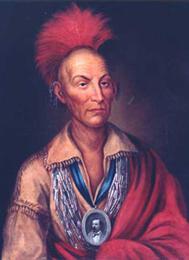
Ma-Ka-Tai-Me-She-Kia-Kiak [aka: a-La-Tai-Me-She-Kia-Kiak], known as Black Hawk, was the elder Sauk war chief who refused to leave his home, called Saukenuk, in order to appease the new U.S. government. Black Hawk's followers, called the "British Band", consisted of approximately 500 warriors and nearly 1500 women and children. In 1832, the British Band returned to Illinois, triggering the reaction of frontier militia and the U.S. Army. During the war, Black Hawk guided the band through Wisconsin wilderness attempting to avoid conflict.

White Cloud, also known as "The Winnebago Prophet" invited Black Hawk and the British Band to return to his village on the Rock River, an act seen as an invasion by the Governor of Illinois.
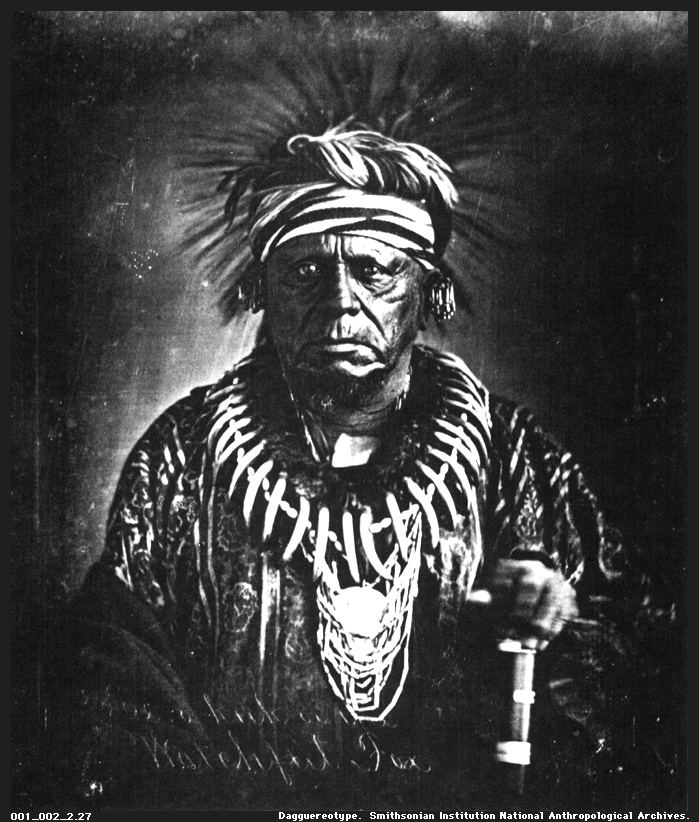
Keokuk was a physically powerful, athletic man, gifted in oratorical skills and prominent among his tribe of the Sauk. He chose to split away from Black Hawk and led his followers to Iowa.
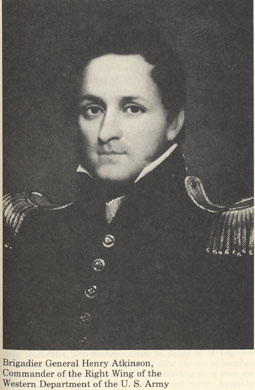
Brigadier General Henry Atkinson was commander of United States troops and militia forces pursuing the British Band from Saukenuk to the site of the Battle of Bad Axe. It was Atkinson's strategy to split up his forces in order to sweep the entire area of the Bad Axe. He actually did not see direct action in the battle.
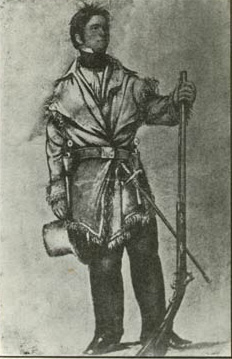
Colonel Henry Dodge, commander of the southwest Michigan Territory (lead district) militia, along with Alexander Henry, first engaged the British Band at Wisconsin Heights. Dodge and Henry's militia also first encountered the Band on the Mississippi floodplain near the Bad Axe River as they were attempting to cross the river.
Further Information
A driving tour of Black Hawk War Markers in Vernon and Crawford Counties, WI has been established by the Vernon County Historical Society. This tour allows individuals to follow the route traveled by Black Hawk and his band, learning about the war as they go.
For a list of all of the Black hawk War Markers in Wisconsin and Illinois, click here: Historical Marker Database